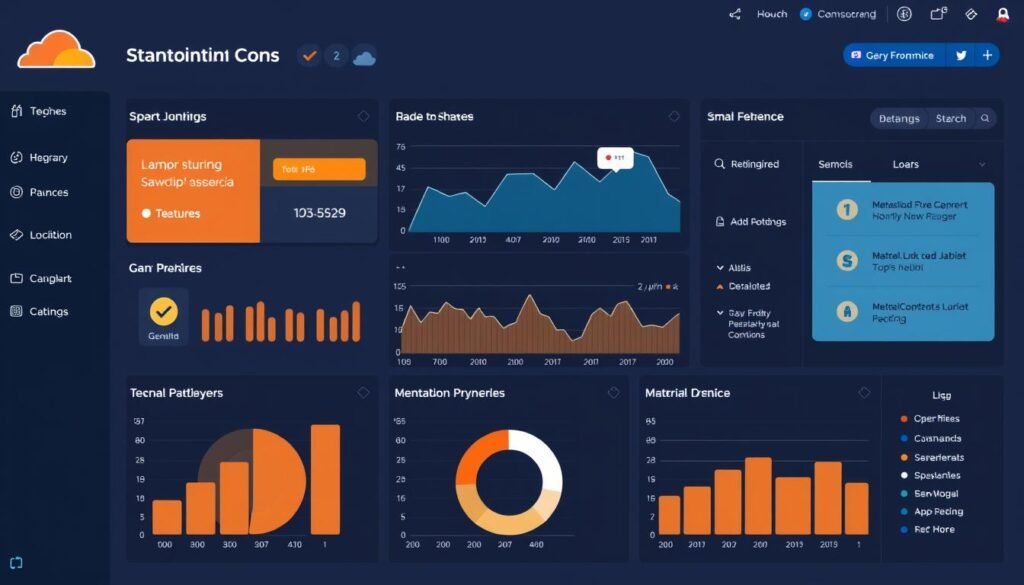In today’s fast-paced digital world, a slow-loading website can be a significant liability. Did you know that a one-second delay in page loading time can result in a 7% reduction in conversions? This surprising statistic highlights the critical importance of website speed for your online success.
As you strive to enhance your website’s performance, it’s essential to understand the intricate connection between speed and key digital marketing metrics. By optimizing your site’s loading times, you can significantly improve user satisfaction and boost conversion rates.
A fast and responsive website not only enhances user experience but also provides a competitive edge in the digital landscape. By the end of this guide, you’ll have a clear understanding of how to transform your site’s speed into a powerful marketing advantage.
Key Takeaways
- Understand the impact of website speed on conversion rates and user satisfaction.
- Learn how to diagnose speed issues and implement effective solutions.
- Discover the connection between website performance and key marketing metrics.
- Gain practical techniques to improve your website’s loading times.
- Transform your site’s speed into a competitive marketing advantage.
Why Website Speed Matters for Digital Marketing
The importance of website speed in digital marketing cannot be overstated, as it directly impacts user experience, engagement, and ultimately, your bottom line. A fast-loading website is crucial for capturing and retaining users’ attention in today’s competitive digital landscape.
Website speed is intricately linked with user experience. When your site loads quickly, users are more likely to stay engaged, explore your content, and ultimately convert. Conversely, slow-loading pages can lead to frustration, increased bounce rates, and a negative impact on your brand’s reputation.
The Connection Between Website Speed and User Experience
A swift and seamless user experience is paramount for digital marketing success. Fast-loading websites tend to have higher average time on page and stronger conversion rates compared to their slower counterparts. This is because users can quickly access the information they need and navigate through your site without interruption.
When Walmart improved its load speed by one second, its conversion rate increased by 2%. This real-world example illustrates the tangible impact of website speed on user experience and business outcomes.
How Speed Impacts Your Digital Marketing Metrics
Your website’s loading speed has a direct influence on critical digital marketing metrics. Even a one-second improvement in load time can yield measurable results in conversion rates and engagement. Slow-loading pages create a domino effect across your marketing funnel, increasing bounce rates, reducing page views per session, and ultimately decreasing your return on marketing investment.
- Search engines like Google use page speed as a ranking factor, meaning slower sites may receive less organic traffic regardless of content quality or relevance.
- Speed optimization creates a competitive advantage in crowded markets, allowing your digital marketing campaigns to outperform competitors who neglect this crucial aspect of user experience.
- The data is clear: faster websites convert better, retain visitors longer, and provide better returns on your digital marketing spend across all channels.
Understanding Website Speed Performance
Delving into the world of website speed performance can help you identify areas for improvement. Your website’s speed is a critical factor that influences user engagement, conversion rates, and ultimately, your online success. With the majority of web traffic now coming from mobile devices, understanding the nuances of website speed performance is more important than ever.
What is Page Load Time?
Page load time refers to the time it takes for a web page to fully load on a user’s device. This metric is crucial because it directly impacts user experience and search engine rankings. A slow-loading page can lead to high bounce rates and decreased user engagement.
A page load time of under 3 seconds is generally considered acceptable, but the faster, the better. You can optimize your website’s page load time by minimizing HTTP requests, leveraging browser caching, and optimizing images.
Average vs. Optimal Website Speed
The average website speed varies depending on the source and methodology used to measure it. However, studies suggest that the average page load time is around 3-5 seconds. Optimal website speed, on the other hand, is typically considered to be under 2 seconds.
To achieve optimal website speed, you need to consider factors such as page size, server response time, and the number of HTTP requests. By optimizing these elements, you can significantly improve your website’s performance and provide a better user experience.
Mobile vs. Desktop Speed Considerations
Mobile users now represent the majority of web traffic, and they typically experience slower loading times than desktop users due to network limitations and device constraints. The performance gap between mobile and desktop experiences creates a critical challenge for digital marketers.
- Mobile optimization requires specific strategies, including responsive design, simplified layouts, and careful management of resource loading.
- Testing your website’s performance across multiple devices and connection types is essential to ensure a smooth user experience.
- With Google’s mobile-first indexing, your site’s mobile performance now directly impacts your search rankings across all devices.
By understanding these factors and optimizing your website’s speed accordingly, you can improve user engagement, increase conversion rates, and drive more traffic to your site.
The Real Cost of a Slow Website

In today’s digital landscape, a slow website is a costly liability. The financial implications of a slow-loading site are multifaceted, affecting various aspects of your online presence, from search engine ranking to conversion rate and ultimately, your bottom line.
A slow website not only frustrates users but also has a tangible impact on your business’s financial health. Understanding these costs is crucial for prioritizing speed optimizations and improving your site’s overall performance.
Impact on Search Engine Rankings
Search engines like Google consider website speed when determining ranking. A slow site can lead to lower rankings, reducing your visibility and making it harder for potential customers to find you. This, in turn, can lead to a decrease in organic traffic and a subsequent loss in revenue.
Improving your site’s speed can enhance its search engine ranking, driving more traffic to your site and potentially increasing your customer base.
Effect on Conversion Rates and Revenue
A slow-loading website can significantly impact your conversion rate. When users are forced to wait for pages to load, they’re more likely to abandon their intended actions, whether it’s making a purchase, filling out a form, or subscribing to a newsletter. Studies have shown that even a one-second delay can result in a noticeable drop in conversion rate, directly affecting your revenue.
By optimizing your site’s speed, you can improve user experience, increase engagement, and ultimately boost your conversion rate and revenue.
Bounce Rate and User Engagement Consequences
A high bounce rate is often a direct consequence of slow loading times. When a website takes too long to load, users are likely to leave without taking any further action, increasing the bounce rate. This not only affects your site’s metrics but also indicates a negative user engagement experience.
A slow website reduces user engagement metrics like pages per session, time on site, and interaction rates. The negative experience can damage brand perception and reduce return visits, creating long-term engagement problems. Moreover, slow performance hampers social sharing and content virality, as users are less likely to share content that provided a frustrating experience.
How to Measure Your Website’s Speed
To optimize your website’s performance, you first need to measure its current speed and identify potential bottlenecks. Measuring your website’s speed involves using various tools that analyze different aspects of your site’s performance.
Essential Website Speed Testing Tools
There are several website speed testing tools available that can provide you with a comprehensive analysis of your site’s performance. These tools assess various metrics, including page load time, time to first byte, and other key performance indicators. Some popular tools include those that offer detailed reports on your website’s performance, helping you identify areas that need improvement.
When selecting a tool, consider one that provides a website speed score and lists the metrics used to calculate it. This information is crucial for understanding your site’s strengths and weaknesses.
Key Performance Metrics to Track
When analyzing your website’s speed, there are several key performance metrics to track:
- Time to First Byte (TTFB): Measures how long it takes for your server to respond to a request, providing insight into server performance and configuration issues.
- First Contentful Paint (FCP): Tracks when the first content appears on screen, giving you a measure of perceived loading speed from the user’s perspective.
- Largest Contentful Paint (LCP): Measures when the largest content element becomes visible, a key Core Web Vital that directly impacts user perception and Google rankings.
- Total Blocking Time (TBT) and First Input Delay (FID): Measure interactivity – how quickly your site responds to user interactions after loading begins.
- Cumulative Layout Shift (CLS): Measures visual stability, tracking how much elements move around during loading, which can frustrate users if too high.
- Page Weight (total KB downloaded): Helps identify bloated resources that could be optimized or eliminated to improve loading times.
- Speed Index: Measures how quickly content is visually displayed during page load, combining several metrics into a single score for overall performance.
By understanding and tracking these metrics, you can gain valuable insights into your website’s performance and make data-driven decisions to improve it. For more information on how to check your website’s speed, you can visit https://mountaintopwebdesign.com/how-fast-is-your-website/.
Marketing Digital Website Speed Optimization Techniques
In the world of digital marketing, a website’s speed can be the difference between success and failure. With the majority of users accessing websites through mobile devices and expecting instant gratification, a slow website can lead to high bounce rates and lost conversions. In this section, we’ll explore various techniques to optimize your website’s speed and improve your digital marketing efforts.
Image Optimization Strategies
Images are a crucial element of any website, but they can also be a significant contributor to page load times. To optimize your images, you can use tools like TinyPNG or ImageOptim to compress your images without sacrificing quality. You can also consider using image formats like WebP, which offer better compression than traditional formats like JPEG and PNG.

When optimizing images, it’s essential to strike a balance between quality and file size. You can achieve this by using the right image format, compressing images, and resizing them to the correct dimensions. By optimizing your images, you can significantly reduce your website’s page load times and improve user experience.
Implementing GZIP Compression
GZIP compression is a technique that reduces the size of your website’s files, making them faster to download. By compressing files like HTML, CSS, and JavaScript, you can reduce the overall size of your webpage and improve page load times. Most modern web servers and browsers support GZIP compression, making it a simple and effective optimization technique.
To implement GZIP compression, you’ll need to configure your web server to compress files before sending them to the browser. You can do this by adding a few lines of code to your server configuration file or by using a plugin or module that supports GZIP compression.
Leveraging Browser Caching
Browser caching is a technique that allows browsers to store frequently-used resources locally, reducing the need to reload them from the server. By leveraging browser caching, you can reduce the number of HTTP requests made to your server, resulting in faster page load times and improved user experience.
To leverage browser caching, you’ll need to set the appropriate cache headers for your website’s resources. This involves specifying how long browsers should cache resources and when they should refresh them. You can use tools like Google PageSpeed Insights to identify opportunities to improve browser caching on your website.
Minimizing HTTP Requests
HTTP requests are a significant contributor to page load times, as each request requires a round trip to the server. To minimize HTTP requests, you can use techniques like file concatenation, CSS sprites, and lazy loading. By reducing the number of HTTP requests, you can significantly improve your website’s page load times and user experience.
One effective way to minimize HTTP requests is to use a content delivery network (CDN). A CDN can distribute your website’s resources across multiple servers, reducing the distance between users and your resources. This can result in faster page load times and improved user experience.
Reducing Server Response Time
Server response time, also known as Time to First Byte (TTFB), is a critical factor in determining your website’s page load times. A slow server response time can negate the benefits of other optimization techniques, making it essential to optimize your server configuration.
To reduce server response time, you can implement techniques like server-side caching, database optimization, and upgrading your hosting plan. By optimizing your server configuration, you can significantly improve your website’s page load times and user experience.
Advanced Speed Optimization Methods
To further enhance your website’s performance, exploring advanced speed optimization methods is crucial. These techniques can significantly improve your website’s speed, user experience, and search engine rankings.
Content Delivery Networks
A Content Delivery Network (CDN) is a distributed network of servers that deliver web content to users based on their geographic location. By caching your website’s content across multiple servers worldwide, CDNs reduce the distance between your site’s visitors and your content, resulting in faster page loads.
When selecting a CDN, consider factors such as server coverage, pricing, and ease of integration. Some of the top CDN services for websites include Cloudflare, Akamai, and Verizon Digital Media Services.

Database Optimization Techniques
Optimizing your database is crucial for improving your website’s performance. This involves cleaning up unnecessary data, optimizing database queries, and ensuring that your database is properly indexed.
Regular database maintenance can significantly reduce query times and improve overall website speed. Techniques include removing redundant data, optimizing SQL queries, and using database caching.
Managing External Scripts and Third-Party Resources
External scripts and third-party resources can significantly impact your website’s load time. To manage these effectively, regularly audit your site’s scripts, remove unnecessary ones, and consider asynchronous loading for non-critical scripts.
Font Optimization Strategies
Optimizing your web fonts is essential for balancing design quality and page performance. Key strategies include limiting font usage to 2-3 font families with no more than 6 total variants, implementing font subsetting to reduce file sizes, and using the font-display CSS property to control text rendering during font loading.
For instance, you can use font subsetting to include only the characters your site actually uses, which can reduce font file sizes by 60-90% for Latin-based languages. Additionally, consider using variable fonts for critical content to reduce HTTP requests.
By implementing these advanced speed optimization methods, you can significantly enhance your website’s performance, providing a better user experience and improving your search engine rankings. For more detailed strategies on load speed optimization, visit our article on advanced strategies for efficient page performance.
Mobile-Specific Speed Optimization
With the majority of internet users now accessing websites through mobile devices, mobile-specific speed optimization is no longer a luxury, but a necessity. Mobile users are even more sensitive to poor page loading and will abandon slow sites much quicker than desktop users. If you ignore mobile optimization and performance, you risk losing a lot of potential profit.
Responsive Design Best Practices
A responsive design ensures that your website adapts to various screen sizes and devices, providing a consistent user experience across different platforms. To achieve this, focus on flexible grids, images, and media queries. Ensure that your website’s layout is flexible and can accommodate different screen sizes and orientations.
By implementing responsive design best practices, you can improve user engagement and conversion rates. Your website will be more accessible to a broader audience, including mobile users who expect a seamless experience.
Accelerated Mobile Pages (AMP) Implementation
Accelerated Mobile Pages (AMP) is an open-source framework designed to create lightning-fast mobile web pages. To implement AMP on your website, you’ll need to create alternate versions of your content pages using the AMP HTML specification. This can be automated through CMS plugins for platforms like WordPress.
AMP pages load 4-10 times faster than standard mobile pages by enforcing a simplified HTML structure, restricted CSS, and JavaScript execution limitations. While there’s a trade-off in terms of reduced functionality and design flexibility, AMP is particularly beneficial for content-heavy websites looking to improve mobile performance dramatically.
Maintaining Optimal Website Speed

Your website’s speed is not a one-time optimization task, but an ongoing process. As your website evolves with new content, features, and technologies, its performance can be affected. Regular checks and updates are necessary to maintain optimal speed.
Regular Speed Audits and Monitoring
To maintain your website’s speed, regular speed audits are crucial. Utilize tools like Google PageSpeed Insights, GTmetrix, or Pingdom to monitor your website’s performance regularly. These tools help identify areas that need improvement, ensuring your website stays fast and efficient.
- Schedule periodic audits to catch performance issues early.
- Monitor key performance metrics such as load time, page size, and requests.
- Use monitoring tools to receive alerts when your website’s performance degrades.
Balancing Speed with Functionality and Design
While optimizing for speed is crucial, it’s equally important to balance it with functionality and design. Not all optimization techniques are suitable for every website; for instance, an e-commerce platform has different requirements than a blog or portfolio site.
To achieve this balance:
- Prioritize optimizations based on user impact, focusing on improvements that affect the most users or critical conversion paths.
- Use A/B testing to evaluate the business impact of performance improvements.
- Consider progressive enhancement strategies to provide a fast basic experience while adding enhanced functionality for users with faster connections.
By maintaining this balance and continuously monitoring your website’s performance, you can ensure a fast, functional, and visually appealing website that supports your digital marketing efforts.
Conclusion
In today’s fast-paced digital landscape, a speedy website is no longer a luxury, but a necessity. Website speed optimization is fundamental to successful digital marketing, impacting every aspect of your online presence.
The techniques covered in this guide provide a comprehensive roadmap for transforming your site’s performance into a competitive advantage. By implementing these strategies, you can significantly improve user experience, boost conversion rates, and enhance search visibility.
Start with high-impact optimizations, focus on critical user paths, and make speed a core component of your ongoing marketing strategy. Regular monitoring and continuous improvement will ensure your website delivers the speed your users expect and your business deserves.
